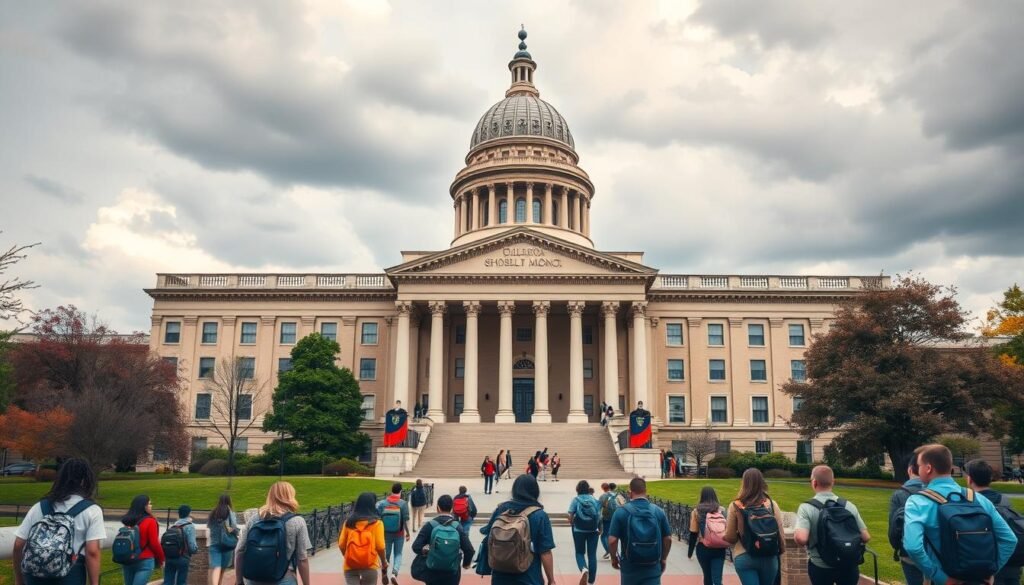What if you could fund your academic goals without the stress of repayment? For many, the idea of accessing no-strings-attached financial support seems too good to be true. Yet thousands of students and educators unlock these opportunities every year.
New York’s Department of Education alone manages a budget exceeding $51 billion, with significant allocations for grants and programs. These funds empower learners at all levels—from high school students to PhD candidates—and support teachers pursuing advanced training.
We simplify the search for tailored funding solutions. Unlike loans, grants provide resources you won’t repay later. Whether you’re launching a research project or expanding classroom tools, our guidance connects you to curated opportunities from government agencies, schools, and nonprofit organizations.
Consider this: over 40% of New Yorkers hold a bachelor’s degree or higher. This achievement is fueled by accessible funding. Our team specializes in matching your goals with the right programs, ensuring you focus on growth—not paperwork.
Key Takeaways
- Grants offer financial support without repayment obligations.
- Government and school programs provide billions in annual funding.
- Funding options exist for students, teachers, and academic projects.
- Tailored guidance streamlines the application process.
- New York’s education budget highlights vast available resources.
Understanding Educational Grants and Funding Opportunities
Navigating funding options requires clear insight into available resources. We break down complex systems into actionable steps, helping you identify solutions that align with your goals.
Public and Institutional Funding Explained
Government programs and school-based initiatives offer distinct advantages. New York’s Department of Education directs $51 billion annually toward initiatives like infrastructure upgrades and teacher training. Recent projects include a $7.2 million vegetation management program to improve campus safety.
Why Choose Non-Repayable Options
Unlike loans, these funds eliminate debt concerns. Students pursuing degrees or teachers expanding certifications gain direct support. Over 63% of New Yorkers with bachelor’s degrees utilized such programs during their studies.
Data-Driven Opportunities
State records show 87% of residents complete high school, creating strong eligibility pools. Districts like Rochester recently secured $4.3 million through DOT corridor grants for STEM lab expansions. We analyze regional trends to match applicants with high-success programs.
Our team simplifies access to these resources. Whether you’re a first-time applicant or managing district-wide projects, we provide tailored strategies to maximize approval chances.
Navigating the Application Process for Educational Grants
Securing financial support begins with understanding how to craft winning applications. We simplify this journey by breaking it into focused stages, from initial research to final submission. For example, New York’s FAFSA portal processes over 1.2 million applications annually—proof that structured systems yield results.
Steps to Submit a Successful Grant Proposal
Start by identifying programs matching your goals. Research deadlines and requirements—many schools prioritize proposals submitted 6-8 weeks before cutoff dates. Gather data like academic records or project budgets early to avoid last-minute delays.
Next, draft a proposal that highlights measurable outcomes. Rochester schools secured $4.3 million by emphasizing STEM lab upgrades in their DOT corridor grant application. Use templates from trusted sources to structure your narrative effectively.
Eligibility, Resources, and Application Tips
Verify eligibility criteria before investing time. Districts with budget constraints often qualify for specific funding pools. Teachers expanding classroom tools can access state-sponsored programs requiring proof of certification.
Address common questions upfront: How will funds be used? What learning outcomes will result? Review committees prioritize clarity. We provide checklists to streamline submission and track progress through each process stage.
Need help? Our team offers personalized guidance to transform complex requirements into actionable steps. Let’s turn your academic vision into a funded reality.
Leveraging Resources and Expert Support for Educational Grants
The right support transforms overwhelming searches into targeted wins. We specialize in pairing applicants with curated funding programs that align with their unique goals—from classroom tech upgrades to community health initiatives.
Accessing Curated Funding Opportunities and Programs
Our team tracks 450+ active opportunities nationwide. The National Science Foundation allocates $200 million annually for STEM projects, while retailers like Dollar General fund literacy programs in rural communities. State-specific policy changes often create new pools—like California’s recent $18 million teacher training initiative.
We analyze data to match your needs with high-success options. Administrators in Texas secured $325,000 through Walmart’s local giving program for after-school coding labs. First-time applicants benefit from our pre-screened lists of low-competition grants.
Expert Guidance for Grant Writing and Research
Strong proposals require more than polished writing. Our advisors help structure narratives that highlight measurable development impacts. A New York school district doubled their success rate by emphasizing student mental health outcomes in their grant proposal.
We provide editable templates and strategy checklists updated for 2024 application trends. Teachers expanding robotics programs recently used our budget justification frameworks to secure $50,000 awards. From initial research to post-approval reporting, our services ensure every dollar creates lasting change.
Conclusion
Empowering your academic journey begins with strategic action. New York’s $51 billion education budget demonstrates how non-repayable funding fuels success—from classroom tech upgrades to STEM lab expansions. Schools in Rochester secured $4.3 million by aligning proposals with regional priorities, proving that data-driven applications yield results.
Understanding eligibility and costs remains critical. Over 60% of degree holders accessed such programs, avoiding loan debt while advancing their goals. Our team simplifies this process through tailored support services, matching your needs with vetted opportunities.
Whether you’re a teacher seeking certification funds or a district administrator managing large-scale projects, we provide the tools to succeed. From proposal templates to deadline trackers, our resources address common questions while reducing application stress.
Ready to transform your vision into reality? Let’s navigate this journey together. Start your funding application today and unlock resources that strengthen schools, uplift communities, and create lasting educational impact.
FAQ
What makes grants better than loans for school funding?
Grants provide financial support that doesn’t require repayment, reducing long-term debt for students and families. Unlike loans, they prioritize access to education by covering costs like tuition, materials, or program fees directly.
How do I find grants specific to New York programs?
Start with the New York State Department of Education website, which lists state-funded opportunities. Many schools and nonprofits also curate local grants—our team helps identify options aligned with your goals, eligibility, and community needs.
What common mistakes should I avoid in grant proposals?
Missing deadlines, unclear budget details, and weak needs statements often lead to rejection. We guide applicants in refining proposals to highlight program impact, student demographics, and measurable outcomes—key factors reviewers prioritize.
Can teachers apply for classroom project funding?
Absolutely. Many grants support educators creating innovative learning environments. Focus on proposals that address specific challenges, like STEM access or literacy gaps, and include data showing how funds will directly benefit students.
How long does the application process typically take?
Timelines vary by program, but plan 6–8 weeks for research, drafting, and revisions. Competitive grants may require partnership letters or district approvals. Our resources streamline this process, helping avoid delays.
Are there grants for non-traditional students or adult learners?
Yes! Many opportunities cater to career changers, part-time students, and those pursuing vocational training. We help match your background with grants emphasizing workforce development, skill-building, or community reintegration.





